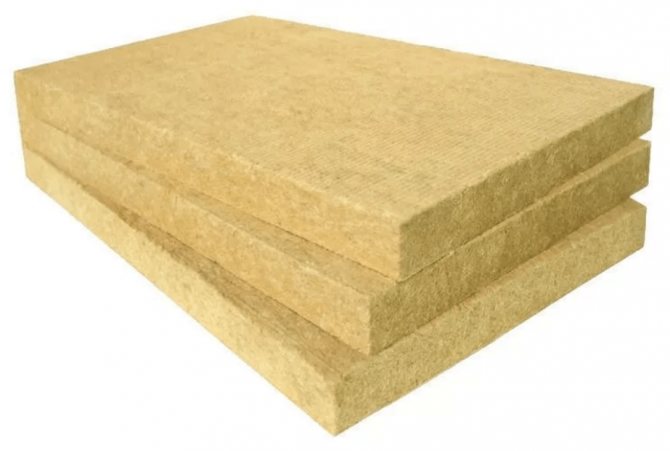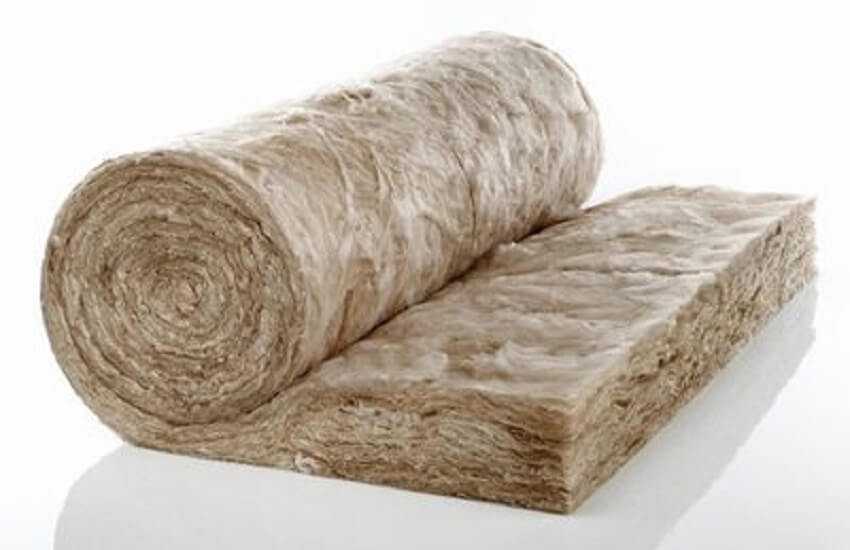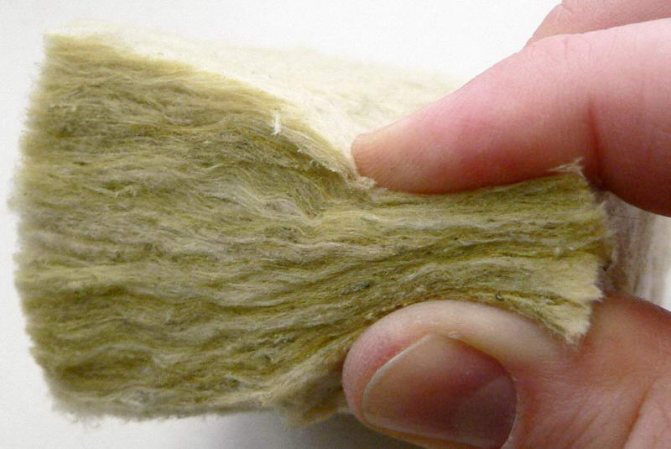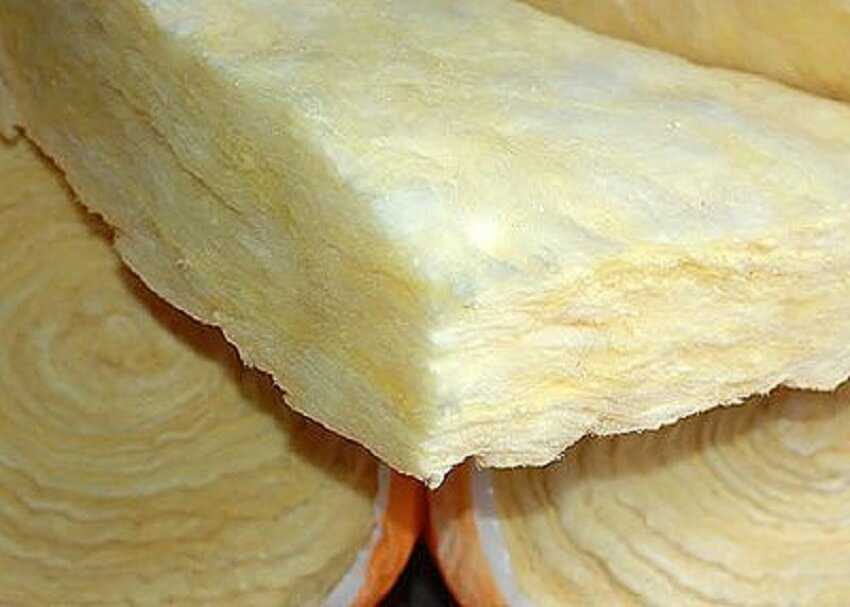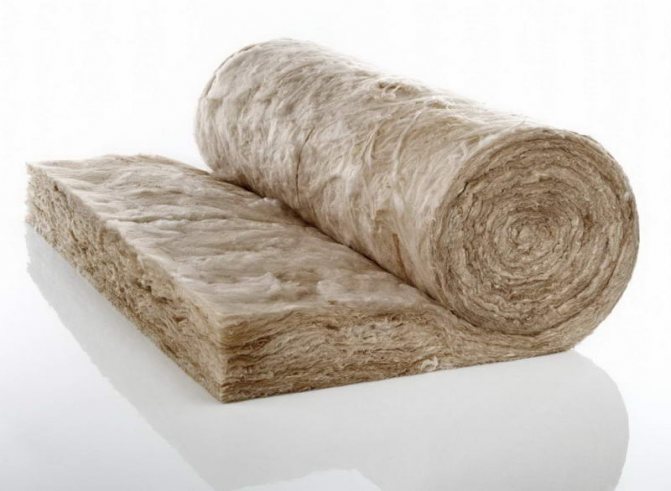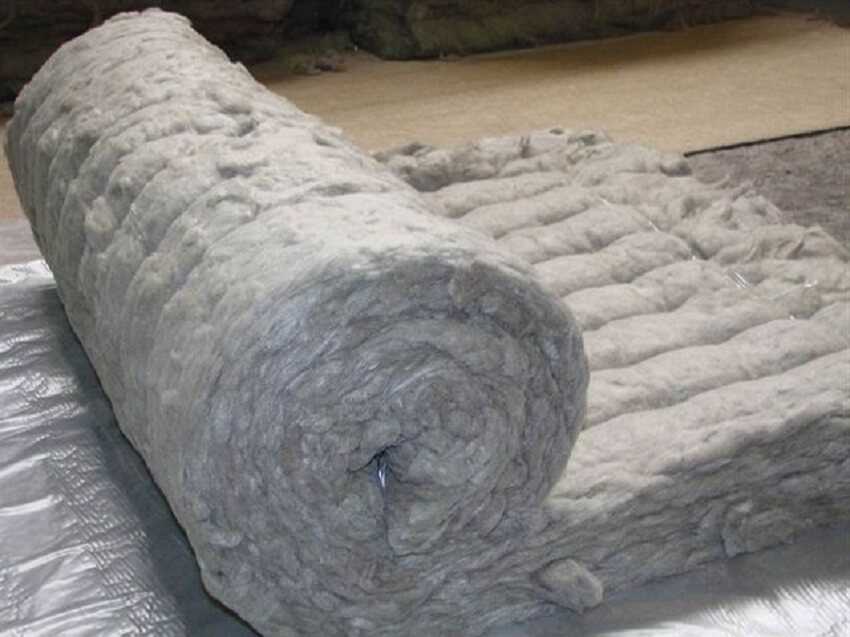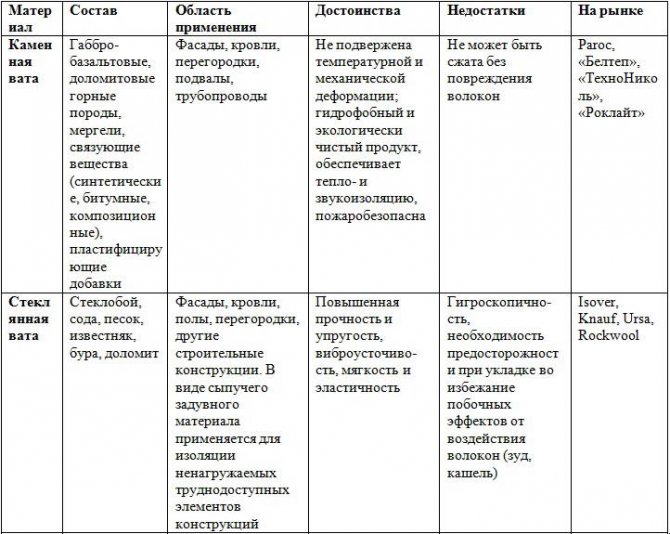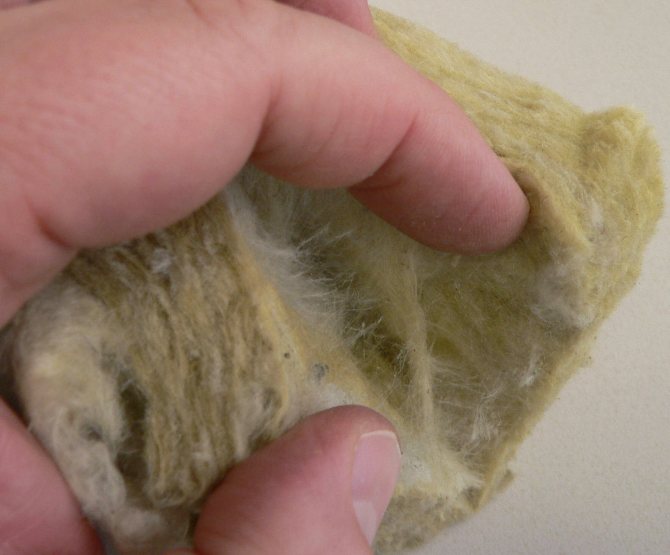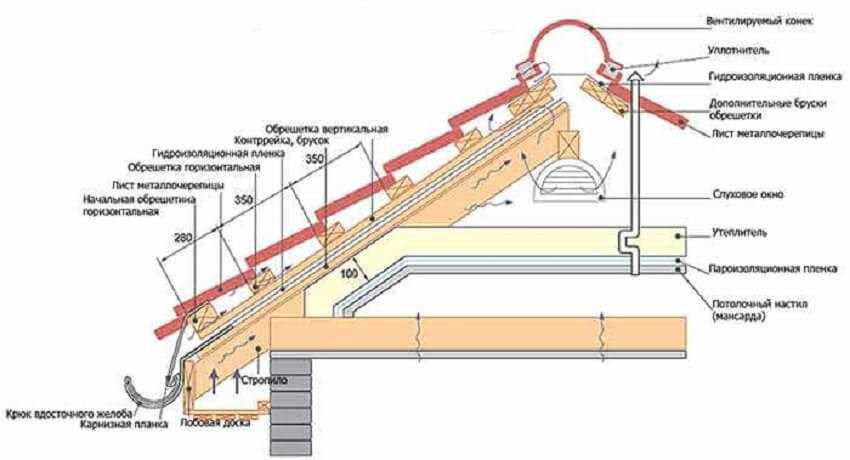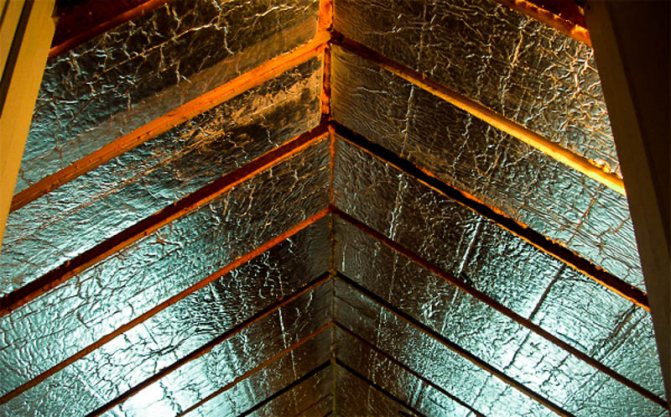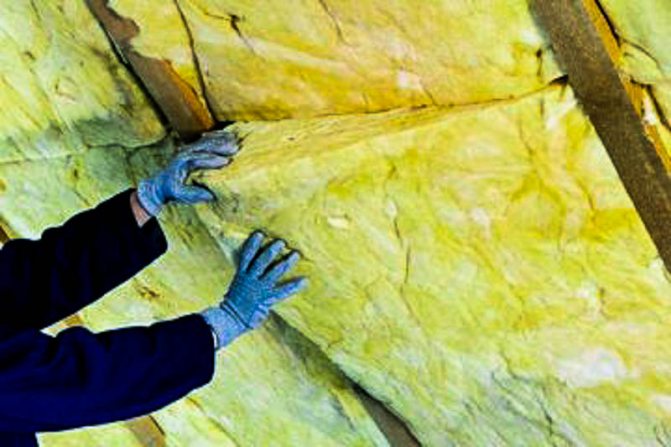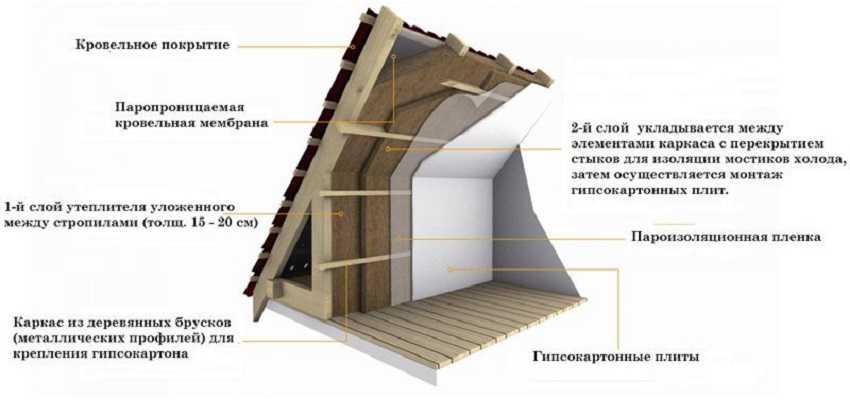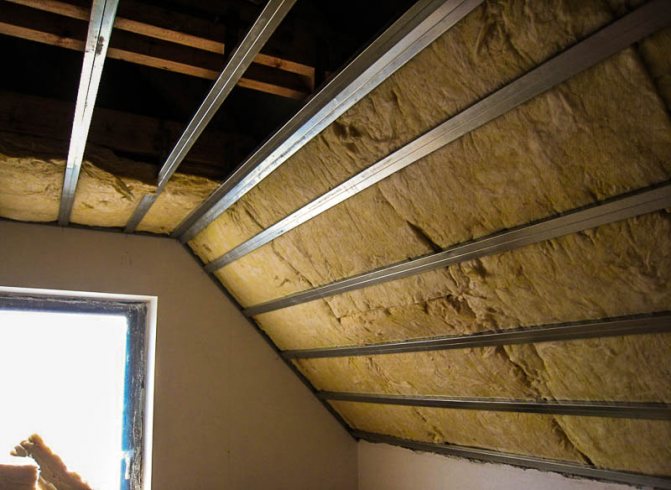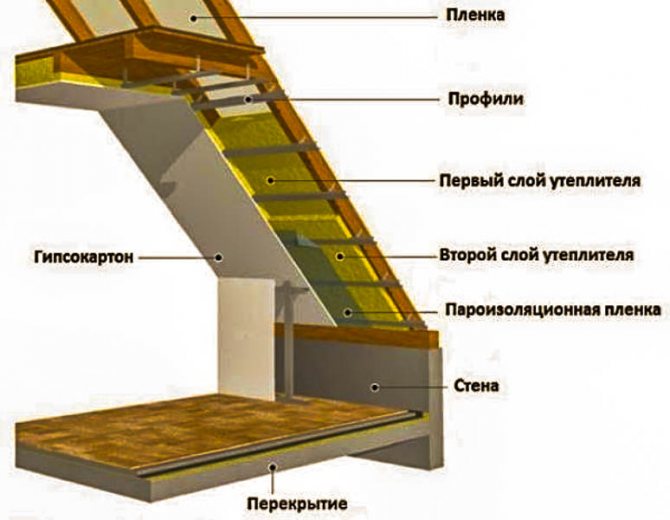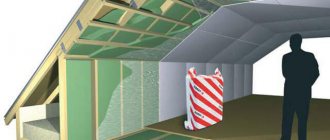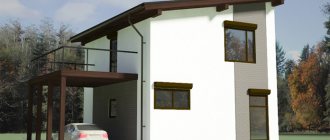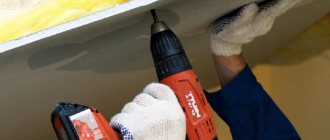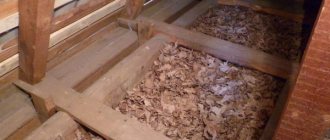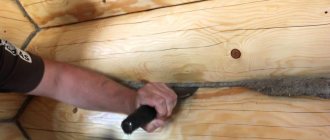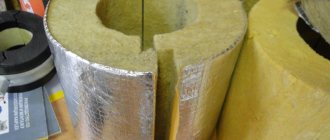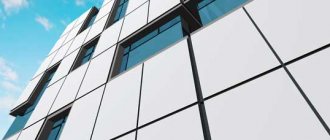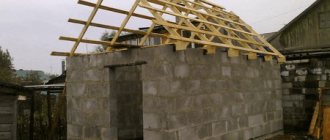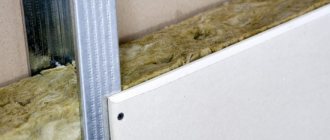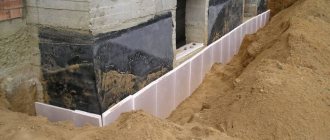What is mineral wool
With the onset of cold weather, the issue of keeping warm in the room becomes especially relevant. The main pathway for heat leakage from rooms is the roof. The zealous owners strive to reduce fuel consumption, insulate the roof from the inside with mineral wool.
Mineral wool is deservedly considered an effective and demanded raw material. The main properties of mineral wool are:
- affordability;
- fire resistance;
- breathability;
- no toxicity.
Release format: in slabs and rolls. In terms of strength, the slabs are ahead of rolls, they are easier to distribute along the perimeter of the roof. Rolls are lighter in weight and cheaper than slabs.
Experts distinguish four types of mineral wool:
- Stone wool is of basalt origin. Due to its short fibers, it does not restore its original shape after compression, panels made of it are hard and not prickly, and do not absorb water well. The blocks are able to withstand high mechanical loads without changing their shape, therefore they are more often used as insulation for flat roofs.

- Glass wool - the manufacturing technology is similar to that of glass. Long fibers give the boards elasticity, softness and excessive looseness. In comparison with stone, it wins in terms of thermal insulation, weight, noise absorption, hygroscopicity and price. Sheets are installed without fasteners for insulating a pitched roof, fragile structures, for repairing heat-insulating coatings.

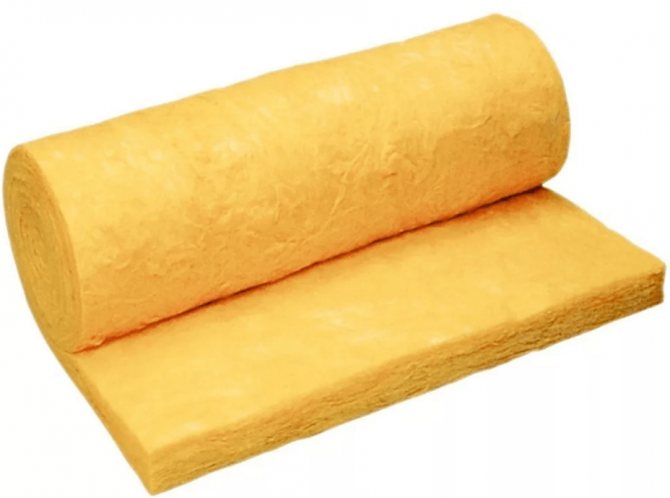
- Slag wool - obtained from blast furnace waste. It is inferior to stone and glass in terms of its ability to insulate heat, but its cost is much lower. It easily oxidizes metal surfaces, quickly absorbs moisture and pricks strongly, therefore, its scope is limited to auxiliary buildings.

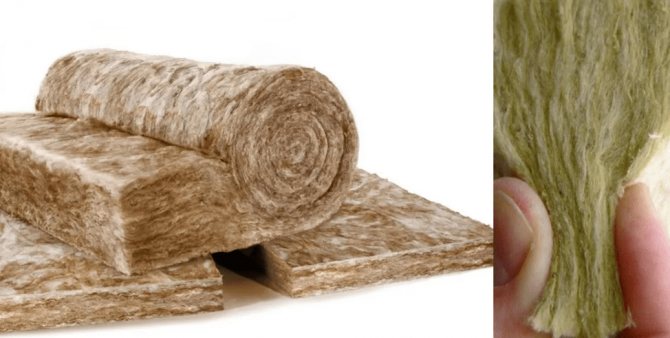
- Basalt - does not contain dolomite, limestone, blast furnace waste. On contact with fire, it does not burn, the fibers are only slightly melted. It is well stored in rolls, has a very low hygroscopicity.

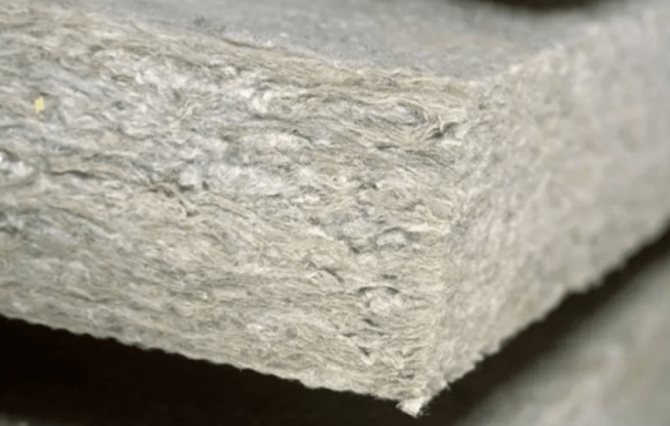
The choice of material for insulation
Today, the choice of heat-insulating materials is so great, and their characteristics are so different, that making the right choice for a particular case can be very difficult.
Most often, developers prefer the following materials as insulation:
- glass wool;
- mineral wool;
- basalt (stone) slabs (there are ready-made sandwich panels with basalt insulation);
- polystyrene (expanded polystyrene);
- polyurethane foam (liquid sprayed insulation).
Recently, Izover, a fiberglass material with a high level of heat and sound insulation, has been especially popular in the insulation of pitched roofs. Due to the content of air in the structure of this material, its low thermal conductivity is ensured, not exceeding 0.044 W / mK. In addition, this material has tremendous durability (at least fifty years), excellent vapor permeability and high fire resistance (flammability class - G1).
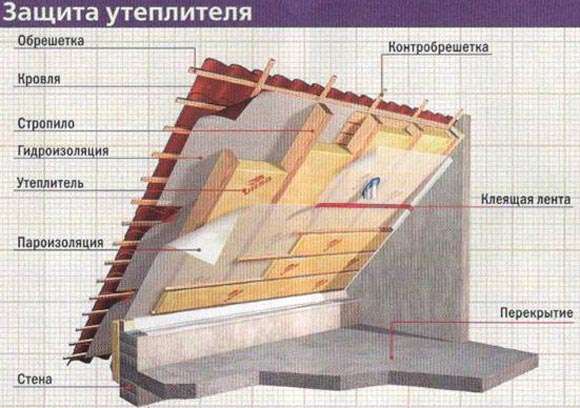

Considering other types of roof insulation, you should pay attention to expanded clay. It is also characterized by excellent heat and sound insulation, environmental friendliness and fire safety.
Since clay is used for its manufacture, it does not lose its properties under the influence of temperature, does not deform and does not emit any substances harmful to humans, which is possible in the case of using synthetic thermal insulation materials.
Pros and cons of mineral wool
Insulation of the roof from the inside with mineral wool is an important point in finishing, it is important not to be mistaken with the material for insulation. Among heaters, mineral wool is considered a favorite due to its many benefits. Pros:
- High fire resistance: the composition includes silicate melts that cannot ignite under the influence of high temperatures, and they also do not undergo deformation.
- Resistance to chemicals: the insulation does not come into contact with various chemical reagents, ensuring safety when cladding educational and research laboratories, factory workshops and school chemistry classes.
- Biological resistance: not affected by molds, not attractive to rodents and insects.
- Low shrinkage, preservation of the original volume, thereby ensuring the tightness of the room, maintaining the design parameters.
- Most types of mineral wool do not absorb water well.
- High permeability of water vapor: cotton wool passes water vapor well without accumulating condensate, so unpleasant odors do not persist in the room, but quickly evaporate.
- High noise-insulating characteristics: not only heat loss will decrease, but also the penetration of loud sounds from the outside.
- Ecology: no allergic reactions, safety for human health.
- Ease of installation: it is not necessary to have professional construction training, roof insulation with mineral wool from the inside with your own hands is up to a novice builder.
- Durability: the service life is around 70 years, so there is no need to change the material several years after installation.
The cheap types of mineral wool, along with the pros, have also disadvantages:
- When working with glass wool, caution is required when insulating the roof from the inside with mineral wool, since when the fibers break and get on the open areas of human skin, pieces of insulation can provoke pain.
- If fragments of glass wool are inhaled, there is a risk of damage to the respiratory tract and lungs. This disadvantage is solved through the use of a respirator, gloves, goggles and a protective suit.
- In the composition of inexpensive types of mineral wool there is a formaldehyde resin capable of oxidation at high temperatures and the release of phenol, a poisonous gas. In the case of working with such materials, experienced craftsmen wear special clothing and a gas mask.
Calculation of the thickness of the insulation and the height of the rafters
The thickness of the insulation layer is directly related to the climatic factors of the region. Basalt insulation with a low density of 25 kg / m3 is best suited for the zones of Moscow and the Moscow region. The use of another insulation over time leads to its subsidence.
The higher the height of the rafters, the thicker the insulation should be. When choosing the optimal height of the boards for the manufacture of rafter legs, they rely on calculations of the thickness and strength of the insulation. In residential buildings located in central Russia, the thickness of the mineral wool layer is within 15 cm; for the northern regions, the thickness is increased.
You can calculate the approximate consumption of insulation and its thickness using our calculator: Calculator for calculating the thickness of insulation for walls or balcony overlap
Pitched roof insulation technology
A pitched roof is a common option. Several options have been developed for its insulation.
Between the rafters
This option is traditional. Before proceeding with the insulation, it is required to make waterproofing with a film on top of the rafters. It protects the room from various effects of precipitation. In addition, construction work can be carried out regardless of weather conditions. The best option is a diffusion type membrane.
Not the entire rafter support is covered with insulation. Make gaps of 2-3 cm.This is required to allow air to enter and dry naturally.
With this method, insulation with a low density is often used. In this case, the material must be additionally fixed. For insulation, it is best to use mineral wool in the form of slabs. Cold bridges will not form.
If the styling includes many layers, it is important to tie up the seams. At each next level, they must be overlapped by products. It is best to use the thickest materials.
If the slope angle is less than 300, then an auxiliary base is equipped for insulation. This will prevent the slabs from sliding.
Do not leave gaps and gaps inside the insulation of pitched roofs along wooden rafters. Layers should be as close to each other as possible.
Over the rafters
This method is rarely used. The process is as follows:
- Lay plywood or chipboard on the rafters. Fix with self-tapping screws.
- Lay a vapor barrier if necessary.
- Lay insulation. Place it tighter and so as to overlap the seams on the previous layers. Fix with glue or dowels.
- Make a waterproofing layer.
- Install the crate.
- Secure the roofing trim.
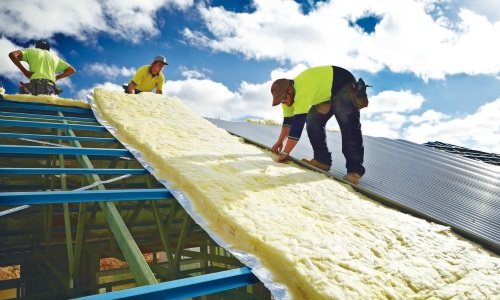

The technology of insulating a pitched roof provides that the layer of insulation will be uninterrupted.
The advantages of this method include the fact that the layer of insulation will be uninterrupted, so that the cold will not penetrate into the room. In addition, the roof supports will not be affected by environmental factors. Another plus is good sound insulation.
It is important to use a durable material for the vapor barrier. After it is laid out, workers will move along the roof, so they can damage it.
The disadvantages include the fact that it will not be possible to carry out work in bad weather. Another disadvantage is the complexity of the work if there are protruding parts on the roof.
Combined insulation technologies
This method of insulation will increase the rate of resistance to heat loss. In this case, materials with different properties can be used so that the roof protection is comprehensive. At the same time, the costs will increase, but the payback periods will be reduced, so this technology is the most common.
When using the method of insulation in 2 layers, the distance between the rafters and on top of them is made. Inside, mineral wool slabs are used, which are soft and lightweight. This layer will keep the heat inside the room.
Rigid slabs are installed on top of the rafters. Typically used are those made of wood fiber.
The joints between the slabs must be on the rafter supports. In this case, the products are well fixed, and the seams are not blown out. The method is well suited for the repair of the roof or its overlap. At the same time, the old layer of insulation is not removed if it has not deteriorated.
Another effective protection option is installation between rafters and inside rooms. In this case, in addition to mineral wool, penofol, cork material or drywall for the inner layer are additionally used. For drywall, additional construction is required.
You can do 3 layers. In this case, noise insulation increases, thermal insulation improves, and the rafters will be protected from the effects of both external and internal factors.
Mineral wool brands
Wool grades for insulation differ in density:
- Mineral wool with a density of up to 75 kg / m3, areas of use are limited.
- P-75.75 kg / cubic meter, is applicable for the insulation of heating plants, oil and gas pipelines, and also for insulating attics.
- P-125, 125 kg / cubic meter, has excellent sound insulation, excellent for insulating floors, interior walls, partitions and ceilings.
- PZh-175, 175 kg / cubic meter, due to its rigidity, serves as an excellent insulating material for metal and reinforced concrete floors.
- PPZh-200, 200 kg / cubic meter, material of increased rigidity, contains special additives that allow to withstand high temperatures without the risk of ignition, is used for thermal insulation of metal walls.
How to cut mineral wool
A construction knife is used to cut the material. If it is absent, a kitchen knife with a grooved edge, a small saw, will do. Minvata in rolls are cut without unpacking. Measure the desired length with a tape measure, fix the cut with tape and cut the desired fragment with a saw in the longitudinal direction. For a transverse cut, the roll is unsealed, unwound a little and an incision is made with a knife or hacksaw.
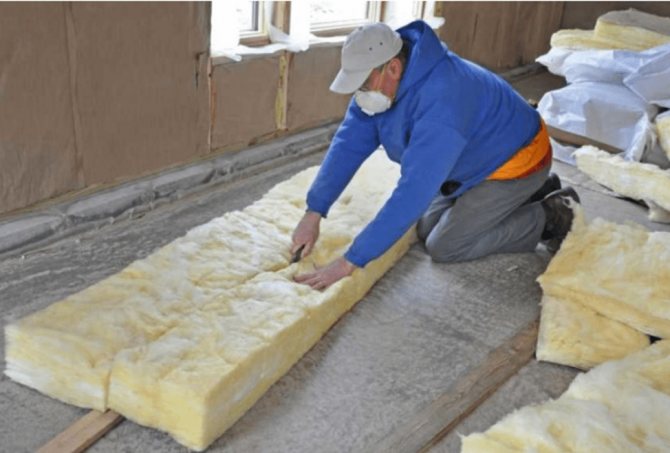

How to insulate a ventilated flat roof
Knowledge of how to properly insulate the roof of a house from the inside with mineral wool will help preserve warm air and reduce heating costs. For this purpose, layers of mineral wool are laid between the rafters, and then secured with ropes and metal brackets using a pistol to avoid shedding. Glass wool is elastic and able to hold between the rafters on its own. Basalt wool is more rigid, and for its fastening it is necessary to build a crate.
The thickness of the material is chosen depending on the climate of the geographical area in which the house is located. If winters are harsh, the layer should be thicker, the panels can be laid in several rows. Mineral wool fibers repel water well, but moisture can accumulate in the voids between them. In the case when water in the insulation accumulates more than 2% of its own weight, its efficiency is reduced by half. To avoid this phenomenon, the insulation strip is protected by a vapor barrier film, which is pulled over the top layer of mineral wool.
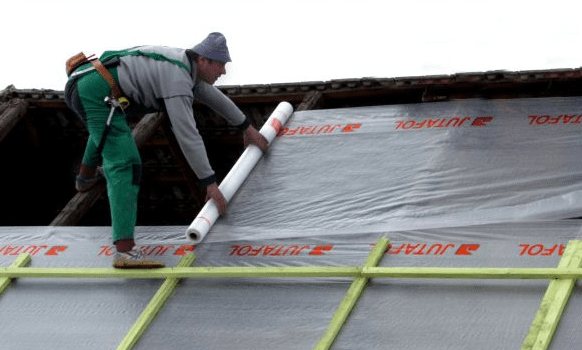

The main stage is the bookmark
The turn of the most important part of the work has come. It consists in the following:
- We glue the original surface with a vapor barrier film (or similar material). Difficulties may arise on a pitched roof, so it is better to do this in small parts with an overlap of at least 10 cm. We glue the joints with a special film - usually it is supplied in the kit.
- After making sure that there are not even the slightest cracks, we begin to create the crate. We attach the bars in parallel to the rafters in increments of no more than 50 cm. You will also need several perpendicular rows, you can in increments of 1 m. We attach them to large screws or nails.
- The result should be a lot of "cells" into which we insert mineral wool. We fix it with a construction stapler (if the inner surface of the roof is plywood or similar material) or with glue. Even the smallest crevices should not be allowed. Firstly, cold air will seep into them, and, secondly, such a defect will lead to the formation of condensation.
- Having completely insulated our pitched roof, we cover it with a vapor barrier membrane. As a result of thermal deformations, it can stretch and tear. Therefore, it should be fixed with a slight slack (especially important for pitched roofs).
- At the end, we cover everything with some sheet material (OSB, plywood, drywall). We fix it on the installed bars.
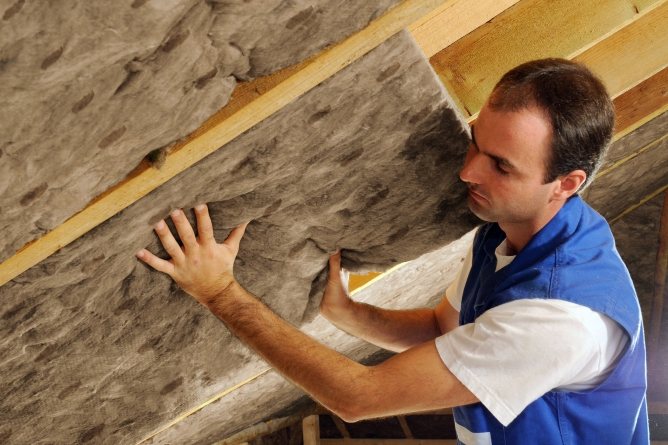

That's all, the roof is protected from cold air penetration.
Above, we considered the option of interior decoration, that is, when a pitched roof is already available, and work is being done in the attic. If the construction of the building has not yet been completed, you can do otherwise. On the inside, we attach the selected sheet material (chipboard, OSB, etc.) to the beams (on which the slate will be attached) and put mineral wool on top of it. This technique is much simpler.
Roof insulation technology with mineral wool
In order to increase the heat-insulating ability of the roof from the inside with the help of mineral wool, it is necessary to select the technology of economically justified insulation by preparing the necessary materials:
- wind protection;
- waterproofing;
- insulation;
- vapor barrier.
To ensure the comfort of the building, as well as to increase the service life, the layers of the roofing cake are arranged in a certain order from the bottom up:
- ceiling sheathing from the inside of the room;
- lower lathing;
- steam isolation;
- rafter legs;
- insulation between the rafters;
- waterproofing;
- lathing;
- roof covering.
Insulation of the roof from the inside with mineral wool - the choice of mineral wool for roof insulation
Following towards technologies that provide roof insulation from the inside with their own hands with mineral wool, manufacturers are constantly updating insulation models, endowing them with unique properties and quality characteristics
Prices for mineral wool
- Foil plates - look decent, but create additional problems, disrupting the natural magnetic background.
- Slabs covered with a film, insulation from steam - the presence of a film does not negate the insulation of the entire surface of the roof from water vapor by a single membrane.
- Slabs with layers of different density - the top layer of increased density, a ventilated facade that is not blown out for normal conditions in the system, but the main one is lighter and more heat-insulating
- Mineral wool, covered with a superdiffusion film - provides vapor-permeable protection of mineral wool against blowing, however, in comparison with others, it is more expensive.
Mineral wool slabs are more durable. When insulating the roof with your own hands, fixing them will not be difficult and will not require special devices.
Insulation of a sloped roof with mineral wool.
During the insulation of the pitched roof, the mineral wool is placed between the rafters. In this case, the size of the strata becomes important. The master chooses the width of the blocks of mineral wool by a couple of centimeters more than the distance between the beams. The sloped roof is insulated with sheets with a density of up to 160 kg / m3. without fixing. After compression, the panels do not regain their shape and do not hold on their own. To strengthen their position, you will need a crate. The attic roof is most often insulated by laying the material inside the frame, which reduces the operating time. Experts advise to insulate the pitched roof during the construction of the building, along with the thermal insulation of the walls of the house from the inside. It is only necessary to carry out work in dry weather. In the autumn, the roof cladding is mounted, and then the insulator is laid from the attic side to the prepared place. It is also possible to insulate the roof with mineral wool from the inside in old buildings.
Insulation of the roof from the inside with mineral wool - thermal insulation of a flat roof
Rigid slabs are used to insulate a flat roof from the inside. Stone wool works best, but high-density glass wool can also do the job. Do not use soft mineral wool samples. When walking on the roof, under the weight of the snow cover, they sag and this can lead to a violation of the integrity of the vapor barrier membrane. To preserve the waterproofing, the sheets are covered with a cement-sand screed and increase the load on the floor, as a result of which the use of the screed depends on the degree of structural strength.
Insulation recommendations from masters
- When laying mineral wool between the rafters, select plates of the appropriate size. This material is inserted "by surprise".
- Experts recommend buying slabs, the thickness of which is 30% less than that of the rafters.
- Inside the house, the truss system is sheathed with a vapor barrier, after which it is trimmed with wooden clapboard or moisture-resistant plasterboard.
- If you decide to save money and purchased ordinary glass wool for insulating the roof of the roof, then carefully protect your skin and respiratory organs from harmful dust that is formed when laying this material.
The video examines the features of the roofing of the roof with mineral wool.
All types of coatings:
metal tile soft tile ceramic tile ondulin corrugated roofing felt roofing
Insulation of the roof from the inside with mineral wool - safety precautions
When working on roof insulation from the inside with your own hands, you need to follow safety rules.
- Carry out insulation work exclusively with goggles and a respiratory mask. Mineral wool fibers trapped in the air can enter the respiratory tract and cause serious discomfort.
- Glass wool particles can get on exposed skin and damage it and cause irritation, so long sleeves will be needed for work.
- Keep material out of reach of children.
- The correct approach after work is to collect all the remnants of the insulation, not to allow it to scatter throughout the yard. Of all types of insulators, glass wool is the most dangerous.
Insulation instructions
If you have never done thermal insulation with mineral wool with your own hands before, then the information presented above is for you. Consider the insulation of the roof of the house in stages - it's easier to figure it out.
What do we need
To get the job done, you will need the following:
- Mineral wool. To calculate the amount of material required, we calculate the roof area. For complex pitched structures, we measure the length and width of the roof itself (tilt compensation). If the roof is completely flat, it is sufficient to multiply the length and width of the building. Add 10-15% to this value for pruning.
- Wooden blocks 4 × 4 cm for creating the lathing. They can be replaced with an aluminum profile, but it is easier to work with wood.
- Vapor barrier material. We recommend using a special waterproofing membrane.
- Fasteners (screws, nails, dowels, etc.).
- A hammer drill or a powerful screwdriver.
- Hammer, saw (any for wood).
- A well-sharpened knife (it is advisable to have a sharpening wheel on hand, since it will blunt very quickly when cutting mineral wool).
- Glue (for pitched structures, it is advisable to use it in large quantities, since the rolls will slip if they are not very securely fixed).
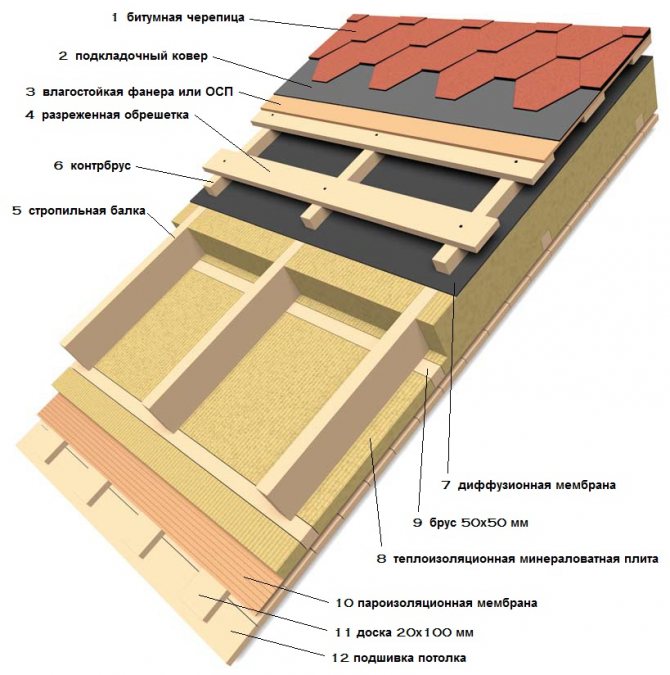

Tips for insulating a roof with mineral wool
Here are a few points that need to be taken into account in connection with the insulation of the roof from the inside with mineral wool.
Roofing material is more often than others exposed to moisture. Water is a known enemy of thermal insulation.
Roof insulation is installed according to the principle of ventilated facades. This means that it is not fenced off from fire by either concrete or plaster elements. You need to choose the type of mineral wool that is least prone to fire.
Regardless of whether it is a flat or pitched roof, the area of roof insulation with mineral wool in both cases is high, so the cost of the material should be affordable and fit organically into the construction estimate.
It is impossible to check the quality of the material upon purchase, but it is possible to determine the condition of the insulator if you adhere to simple rules:
- Buy dry products. Moisture reduces the basic characteristics of the slabs, promotes decay of wooden beams and battens.
- Store insulation in a dry and ventilated place. In the case of outdoor storage, the products must be carefully packed in a sealed plastic wrap.
- Purchase mineral wool exclusively in branded hardware stores in order to avoid buying counterfeit goods.
- High-quality products are provided with a label with all the necessary information about the characteristics, release date, and areas of application.
- The cost of the goods depends on the degree of the manufacturer's popularity, the type of mineral wool, the stiffness of the sheets and the uniformity of the block density.
- German manufacturers, who are anxious about the certification of insulators, are rightfully considered the leader in the production of quality products.
However, it is not enough to simply insulate the roof and put a thick layer of mineral insulation. When installing mineral wool, many mistakes can be made that affect the decrease in the effectiveness of insulation and the increase in heat loss of the building.
Insulation of various kinds of roofs with mineral wool
Mineral wool can be used to insulate both rafter pitched roofs and flat concrete roofs. For each type of work, you need to select a special thermal insulation. Important characteristics:
- what the mineral wool is made of (basalt, glass, quartz);
- density;
- hygroscopicity;
- presence / absence of a soft end.
Choosing which heater is better for an apartment is necessary among electrical appliances, all other heating appliances are not suitable.
If the convector heater does not work, then the reason is most likely in the breakdown of the heating element. More details here.
Rafter roof
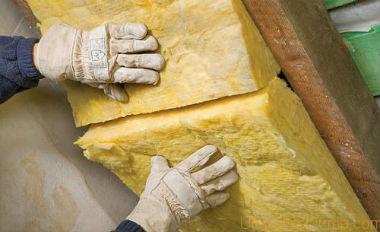

Glass wool is placed between the guide rails.
For thermal insulation of the rafter roof, it is better to use glass wool with a density of 55 kg / m. cub. It is soft, lightweight and elastic. Its fibers are long, do not break and do not form dust. Glass wool is much easier to work with. It fits between the guide rails. It is advisable to lay the material in two layers with displaced joints. This will block the cold bridges at the joints.
Thermal insulation of the rafter roof from the inside with mineral wool, technology:
- vapor barrier layer. Polypropylene is laid with an overlap, and penofol is a butt joint. The seams are glued;
- thermal insulation - it is important to correctly calculate the thickness;
- polypropylene diffusion membrane;
- counter-lattice to create a ventilated gap;
- outdoor decoration.
If the vapor barrier is without aluminum spraying, then it does not matter which side to put it on. Reflective materials are placed inside the room with foil. The membrane must be laid with the rough side facing the thermal insulation. The villi draws moisture from the mineral wool and remove it outside, thereby accelerating the circulation of steam. The membrane strips are laid horizontally from the edge of the roof to the ridge. Thus, each new tape overlaps the previous one. This prevents dripping drops from entering the seam.
Concrete roof
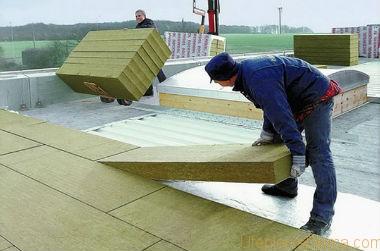

Basalt wool with a high density is selected for the concrete roof.
To insulate a flat roof, it is necessary to provide not only insulation, steam and waterproofing, but also the outflow of liquid. Therefore, the roof should be made at a slight slope (1.5-2%), and special drainage systems are additionally installed on large objects. At the first stage, you need to prepare the surface for laying waterproofing. For this, the roof is leveled and cleaned. If you chose mastic as a vapor barrier, then installation comes down to spreading it on the work surface in two layers.
Bituminous rolls are fused onto the primed surface. For this, the adhesive side is heated with an open flame until the inscription disappears from it. The tapes are laid with an overlap of 10-15 cm, and the joints are additionally smoothed with a rubber roller. On top of the insulation, mineral wool is placed in two layers. For these purposes, brands of mineral wool are specially produced for the lower and upper layers (pay attention to the recommendations of the manufacturers). Layer joints should not overlap. There is also a single layer of mineral wool for roof insulation. You should choose a material with a high density, since it will be exposed to strong loads during operation (for example, snow in winter).
On flat roofs, waterproofing is applied with an overlap on the parapet.
Waterproofing is laid on top of the insulation. The best option is a PVC membrane, which is mechanically attached by means of dowels. The tapes are overlapped so that the dowels are closed. The joints are soldered and additionally glued with PVC glue.To fix the ends of the film to the working surface, use special corners, which are covered with a PVC layer on the outside. The corners are fixed with dowels, and the film is soldered to the polymer surface. If you want the roof to be used, then paving slabs can be laid on top of the membrane, having previously covered the working surface with sand.
Insulation of the roof from the inside with mineral wool - installation errors
Most often, heat leakage can occur at the joints between thermal insulation and timber beams. This usually happens because the mineral wool does not fit tightly to the beam, leaving gaps.
The beam is also a heat bridge, as it comes into direct contact with the concrete slab and heats up. It is best to insulate the beam itself by blocking its top, for example, with an additional layer of thermal insulation. Another weak point, although it is rare, is the knot between the floor and the wall. Most often, the entire roof should be insulated. Then the main problem becomes the choice of high-quality insulation and sealing of the joint. If the joint is poorly sealed and the wind blows under the roof, then cold air quickly spreads along the walls. It increases heat loss in rooms, causing a draft. When insulating a roof with mineral wool, inaccuracies are most often made due to incorrect installation, the appearance of thick seams, if the insulation is damaged or crumpled, moisture gets on it, the wrong device or lack of steam and water protection. The use of insulation from scraps of cotton wool is initially doomed to failure, leading to uneven heat losses and a decrease in the effectiveness of insulation in general. Also, a weak spot in the insulation is the joint between the roof and the load-bearing wall.

